Below are some of my publications and working papers.
(If you can't access a pay-walled article, please email me to request a copy)
(If you can't access a pay-walled article, please email me to request a copy)
Publications
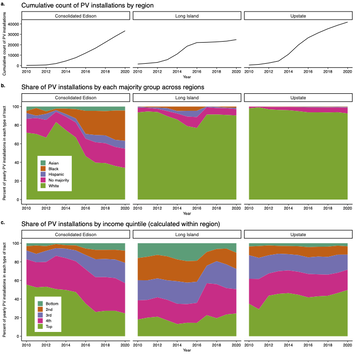
"Closing the Green Gap?: Trends in Residential Solar Installation Disparities by Race, Income, and Rurality.”
Energy Research & Social Science, Forthcoming (with Mircea Gherghina and Brian Thiede)
The push to accelerate the transition to renewable energy sources raises questions about how associated costs and benefits are distributed. The likelihood that individuals and communities benefit from access to solar photovoltaics (PV) may vary systematically, between social groups and across space. The present study leverages high-resolution and uniquely comprehensive data on nearly all residential solar PV installations in New York State to measure disparities (and their trends over time) in PV deployment across three axes: ethno-racial composition, income, and rural-urban status. We identify notable differences in solar PV adoption rates across all three dimensions and show that deployment gaps changed dramatically between 2010 and 2020. White-majority census tracts maintained a substantial advantage in PV adoption early on, but minority-majority tracts narrowed and eventually overtook White-majority tracts in terms of variable-adjusted PV deployment rates in New York. However, PV deployment gaps across income and rural-urban status have largely persisted. Finally, an analysis comparing deployment trends across three regions of New York State reveals that trends in a single region, consisting largely of New York City, account for major shifts in overall disparities. The important implication is that policies and market processes unfolding at the local level critically shape distributional outcomes in PV deployment.
Energy Research & Social Science, Forthcoming (with Mircea Gherghina and Brian Thiede)
The push to accelerate the transition to renewable energy sources raises questions about how associated costs and benefits are distributed. The likelihood that individuals and communities benefit from access to solar photovoltaics (PV) may vary systematically, between social groups and across space. The present study leverages high-resolution and uniquely comprehensive data on nearly all residential solar PV installations in New York State to measure disparities (and their trends over time) in PV deployment across three axes: ethno-racial composition, income, and rural-urban status. We identify notable differences in solar PV adoption rates across all three dimensions and show that deployment gaps changed dramatically between 2010 and 2020. White-majority census tracts maintained a substantial advantage in PV adoption early on, but minority-majority tracts narrowed and eventually overtook White-majority tracts in terms of variable-adjusted PV deployment rates in New York. However, PV deployment gaps across income and rural-urban status have largely persisted. Finally, an analysis comparing deployment trends across three regions of New York State reveals that trends in a single region, consisting largely of New York City, account for major shifts in overall disparities. The important implication is that policies and market processes unfolding at the local level critically shape distributional outcomes in PV deployment.
"A Framework to Centre Justice in Energy Transition Innovations.”
Nature Energy, 2023 (with Patricia Romero-Lankao, Nicole Rosner, Christof Brandtner, Christopher Rea, Adolfo Mejia-Montero, Francesca Pilo, Vanesa Castan-Broto, Sarah Burch & Scott Schnur)
The important role of justice in energy transition technologies has been a topic of increasing interest in recent years. However, key questions remain about how inequities influence energy transition innovations (ETIs) from their design to their widespread use, which ETIs receive more funding, and who controls ETI research, prototyping and deployment. Here we propose a framework to centre justice in energy transition innovations (CJI) and examine how three tenets of justice (recognition, procedural and distributional justice) influence each level of ETI, including niche, regime and landscape levels. We examine wind energy in Mexico and multiple ETIs in Los Angeles as use cases to show how our CJI framework can help reveal the specific inequities undermining just energy transitions at crucial analytical levels of ETI in practice. Our CJI framework offers a path for promoters, practitioners and underserved communities to target the problems these groups face and create ETIs that better address their specific aspirations, needs and circumstances.
Nature Energy, 2023 (with Patricia Romero-Lankao, Nicole Rosner, Christof Brandtner, Christopher Rea, Adolfo Mejia-Montero, Francesca Pilo, Vanesa Castan-Broto, Sarah Burch & Scott Schnur)
The important role of justice in energy transition technologies has been a topic of increasing interest in recent years. However, key questions remain about how inequities influence energy transition innovations (ETIs) from their design to their widespread use, which ETIs receive more funding, and who controls ETI research, prototyping and deployment. Here we propose a framework to centre justice in energy transition innovations (CJI) and examine how three tenets of justice (recognition, procedural and distributional justice) influence each level of ETI, including niche, regime and landscape levels. We examine wind energy in Mexico and multiple ETIs in Los Angeles as use cases to show how our CJI framework can help reveal the specific inequities undermining just energy transitions at crucial analytical levels of ETI in practice. Our CJI framework offers a path for promoters, practitioners and underserved communities to target the problems these groups face and create ETIs that better address their specific aspirations, needs and circumstances.
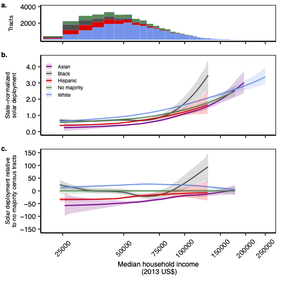
"Revised Estimates of Racial and Ethnic Disparities in Rooftop PV Deployment in the United States.”
Nature Sustainability, 2023 (with Brian Thiede)
We report our discovery of significant problems with Sunter, Castellanos, and Kammen’s (SCK) recent study of racial and ethnic disparities in rooftop PV deployment published in Nature Sustainability. First, we identify irregularities in SCK’s reported procedures and results that are statistically implausible. Second, we report results from a failed replication of their analyses. We correct the implausible absolute deployment figures and identify racial and ethnic disparities that differ substantially from those reported by SCK. We also extend SCK’s analysis, showing that white-majority tracts have the largest deployment advantages in states with the most developed PV markets, whereas deployment estimates in Black and other minority-majority tracts are (artificially) inflated by relatively higher deployment in states with very little solar. In our view, an accurate accounting of racial and ethnic disparities in PV deployment is necessary to develop interventions that effectively and equitably promote sustainable energy transitions.
Replication code/data: https://doi.org/10.7910/DVN/HOH3DR
Preprint: https://osf.io/preprints/socarxiv/x6z25/
Nature Sustainability, 2023 (with Brian Thiede)
We report our discovery of significant problems with Sunter, Castellanos, and Kammen’s (SCK) recent study of racial and ethnic disparities in rooftop PV deployment published in Nature Sustainability. First, we identify irregularities in SCK’s reported procedures and results that are statistically implausible. Second, we report results from a failed replication of their analyses. We correct the implausible absolute deployment figures and identify racial and ethnic disparities that differ substantially from those reported by SCK. We also extend SCK’s analysis, showing that white-majority tracts have the largest deployment advantages in states with the most developed PV markets, whereas deployment estimates in Black and other minority-majority tracts are (artificially) inflated by relatively higher deployment in states with very little solar. In our view, an accurate accounting of racial and ethnic disparities in PV deployment is necessary to develop interventions that effectively and equitably promote sustainable energy transitions.
Replication code/data: https://doi.org/10.7910/DVN/HOH3DR
Preprint: https://osf.io/preprints/socarxiv/x6z25/
"The Public Speaks: Using Large-Scale Public Comments Data in Public Response Research."
Energy Research and Social Science, 2022
The public speaks: Using large-scale public comments data in public response researchPublic response to energy projects affects the emergence of new technologies and the distribution of their risks and benefits. Here we use thousands of individually authored comments submitted during a regulatory review of unconventional shale gas development in New York State to reconcile previous, inconsistent results about the relationship between proximity and opposition to energy projects. We find that members of the public opposed unconventional shale gas development for different reasons, which varied systematically with proximity to unconventional gas wells. Public discourse in proximate communities was diverse, invoking environmental, social, economic and political impacts, and was anchored by concerns specific to a particular place. By contrast, a few nationally salient environmental concerns dominated public discourse in communities farther from development. Our results demonstrate that public response reflects the mobilization of alternative constituencies with unique understandings of the issue. Distinguishing among these is critical for understanding the nature of public response.
Energy Research and Social Science, 2022
The public speaks: Using large-scale public comments data in public response researchPublic response to energy projects affects the emergence of new technologies and the distribution of their risks and benefits. Here we use thousands of individually authored comments submitted during a regulatory review of unconventional shale gas development in New York State to reconcile previous, inconsistent results about the relationship between proximity and opposition to energy projects. We find that members of the public opposed unconventional shale gas development for different reasons, which varied systematically with proximity to unconventional gas wells. Public discourse in proximate communities was diverse, invoking environmental, social, economic and political impacts, and was anchored by concerns specific to a particular place. By contrast, a few nationally salient environmental concerns dominated public discourse in communities farther from development. Our results demonstrate that public response reflects the mobilization of alternative constituencies with unique understandings of the issue. Distinguishing among these is critical for understanding the nature of public response.
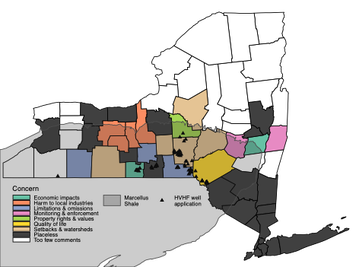
"Variation of Public Discourse about the Impacts of Fracking with Geographic Scale and Proximity to Proposed Development.”
Nature Energy, 2021
Public response to energy projects affects the emergence of new technologies and the distribution of their risks and benefits. Here we use thousands of individually authored comments submitted during a regulatory review of unconventional shale gas development in New York State to reconcile previous, inconsistent results about the relationship between proximity and opposition to energy projects. We find that members of the public opposed unconventional shale gas development for different reasons, which varied systematically with proximity to unconventional gas wells. Public discourse in proximate communities was diverse, invoking environmental, social, economic and political impacts, and was anchored by concerns specific to a particular place. By contrast, a few nationally salient environmental concerns dominated public discourse in communities farther from development. Our results demonstrate that public response reflects the mobilization of alternative constituencies with unique understandings of the issue. Distinguishing among these is critical for understanding the nature of public response.
Replication code/data: https://doi.org/10.7910/DVN/XHSVTN
Nature Energy, 2021
Public response to energy projects affects the emergence of new technologies and the distribution of their risks and benefits. Here we use thousands of individually authored comments submitted during a regulatory review of unconventional shale gas development in New York State to reconcile previous, inconsistent results about the relationship between proximity and opposition to energy projects. We find that members of the public opposed unconventional shale gas development for different reasons, which varied systematically with proximity to unconventional gas wells. Public discourse in proximate communities was diverse, invoking environmental, social, economic and political impacts, and was anchored by concerns specific to a particular place. By contrast, a few nationally salient environmental concerns dominated public discourse in communities farther from development. Our results demonstrate that public response reflects the mobilization of alternative constituencies with unique understandings of the issue. Distinguishing among these is critical for understanding the nature of public response.
Replication code/data: https://doi.org/10.7910/DVN/XHSVTN
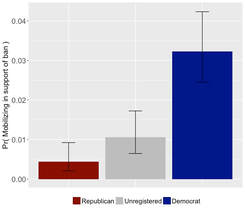
"NIMBYs and Partisans: How Material Interests and Partisanship Shape Public Response to Shale Gas Development.”
Environmental Politics, 2020
The influence of material interests and partisanship on local residents’ responses to proposed shale gas development (SGD) is examined. Complementing existing research on attitudes toward SGD, public response is conceptualized and measured as a political behavior. A novel research design combines information on participation in town board hearings with administrative data from three sources: county tax assessment rolls, a database of gas leases, and the state voter registration file. Consistent with the theory of expressive partisanship, party affiliation strongly predicts public expression of support for and opposition to a proposed local ban on SGD, net of the effects of key measures of material interests. The study contributes to research on public response to industrial siting and to ongoing debates about partisan polarization and political participation.
Environmental Politics, 2020
The influence of material interests and partisanship on local residents’ responses to proposed shale gas development (SGD) is examined. Complementing existing research on attitudes toward SGD, public response is conceptualized and measured as a political behavior. A novel research design combines information on participation in town board hearings with administrative data from three sources: county tax assessment rolls, a database of gas leases, and the state voter registration file. Consistent with the theory of expressive partisanship, party affiliation strongly predicts public expression of support for and opposition to a proposed local ban on SGD, net of the effects of key measures of material interests. The study contributes to research on public response to industrial siting and to ongoing debates about partisan polarization and political participation.
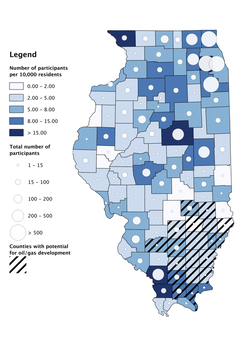
“Not in Your Backyard!: Partisanship, Organizational Structure, and the Mobilization of Non-Beneficiary Constituents against 'Fracking' in Illinois, 2013-2014.”
Socius, 2018 (with Amanda Buday)
In the interest of enlarging their constituency, social movements often broaden mobilization efforts beyond the directly aggrieved, beneficiary population. We examine this process through an analysis of a movement against unconventional oil and gas development (UOGD or “fracking”) in Illinois. Using data on over 37,000 public comments submitted during a regulatory review of fracking, we examine the composition of the anti-fracking movement’s constituency. Individuals residing outside the targeted development region submitted the vast majority of the comments opposing UOGD. Analyses reveal that these participants tend to be Democratic partisans who were affiliated with one or more large environmental and progressive organizations. The study offers new insight into how environmental and progressive issue campaigns are organized in the contemporary U.S. context. We highlight how partisan discursive opportunities combine with recent organizational innovations in the social movement sector to enable nascent single-issue campaigns to tap into the mobilization potential of motivated partisans.
Socius, 2018 (with Amanda Buday)
In the interest of enlarging their constituency, social movements often broaden mobilization efforts beyond the directly aggrieved, beneficiary population. We examine this process through an analysis of a movement against unconventional oil and gas development (UOGD or “fracking”) in Illinois. Using data on over 37,000 public comments submitted during a regulatory review of fracking, we examine the composition of the anti-fracking movement’s constituency. Individuals residing outside the targeted development region submitted the vast majority of the comments opposing UOGD. Analyses reveal that these participants tend to be Democratic partisans who were affiliated with one or more large environmental and progressive organizations. The study offers new insight into how environmental and progressive issue campaigns are organized in the contemporary U.S. context. We highlight how partisan discursive opportunities combine with recent organizational innovations in the social movement sector to enable nascent single-issue campaigns to tap into the mobilization potential of motivated partisans.
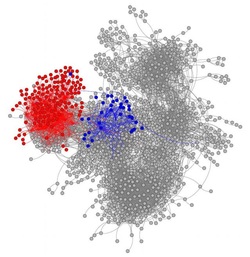
Millions of Online Book Co-Purchases Reveal Partisan Differences in the Consumption of Science
Nature Human Behaviour, 2017 (with Feng (Bill) Shi, Yongren Shi, James Evans, and Michael Macy)
Passionate disagreements about climate change, stem cell research, and evolution raise concerns that science has become a new battlefield in the culture wars. We used data derived from millions of online co-purchases as a behavioral indicator for whether shared interest in science bridges political differences or selective attention reinforces existing divisions. Findings reveal partisan preferences both within and across scientific disciplines. Across fields, customers for liberal or “blue” political books prefer basic science (e.g., physics, astronomy, and zoology), while conservative or “red” customers prefer commercially applied science (e.g., medicine, criminology, and geophysics). Within disciplines, red books tend to be co-purchased with a narrower subset of science books on the periphery of the discipline. We conclude that the political left and right share an interest in science in general, but not science in particular.
Nature Human Behaviour, 2017 (with Feng (Bill) Shi, Yongren Shi, James Evans, and Michael Macy)
Passionate disagreements about climate change, stem cell research, and evolution raise concerns that science has become a new battlefield in the culture wars. We used data derived from millions of online co-purchases as a behavioral indicator for whether shared interest in science bridges political differences or selective attention reinforces existing divisions. Findings reveal partisan preferences both within and across scientific disciplines. Across fields, customers for liberal or “blue” political books prefer basic science (e.g., physics, astronomy, and zoology), while conservative or “red” customers prefer commercially applied science (e.g., medicine, criminology, and geophysics). Within disciplines, red books tend to be co-purchased with a narrower subset of science books on the periphery of the discipline. We conclude that the political left and right share an interest in science in general, but not science in particular.

A Member Saved is a Member Earned?: The Recruitment-Retention Trade-Off and Organizational Strategies for Membership Growth
American Sociological Review, 2017 82(2):407–434 (with Yongren Shi, Michael Genkin, and Matthew Brashears)
A long line of research documents the essential role of social networks in mediating the recruitment and retention of members in organizations. But organizations also comprise a primary context where people form social ties. We investigate how the network structure that an organization creates among its members influences its ability to grow and reproduce itself. In particular, we propose that two dimensions of organizational strategy influence affiliation dynamics: (1) the extent to which the organization induces social interaction among its members (social encapsulation), and (2) the time and energy that the organization demands of its members. We examine membership dynamics in an ecology where competitor organizations deploying varied strategies vie for the same pool of members. Results show a curvilinear relationship between membership growth and the rate of social encapsulation. Further, we find that an organization’s time and energy demand mediates the effect of social encapsulation. For most types of organizations attaining sustained growth requires a balance between open networks (for recruitment) and network closure (for retention).
American Sociological Review, 2017 82(2):407–434 (with Yongren Shi, Michael Genkin, and Matthew Brashears)
A long line of research documents the essential role of social networks in mediating the recruitment and retention of members in organizations. But organizations also comprise a primary context where people form social ties. We investigate how the network structure that an organization creates among its members influences its ability to grow and reproduce itself. In particular, we propose that two dimensions of organizational strategy influence affiliation dynamics: (1) the extent to which the organization induces social interaction among its members (social encapsulation), and (2) the time and energy that the organization demands of its members. We examine membership dynamics in an ecology where competitor organizations deploying varied strategies vie for the same pool of members. Results show a curvilinear relationship between membership growth and the rate of social encapsulation. Further, we find that an organization’s time and energy demand mediates the effect of social encapsulation. For most types of organizations attaining sustained growth requires a balance between open networks (for recruitment) and network closure (for retention).
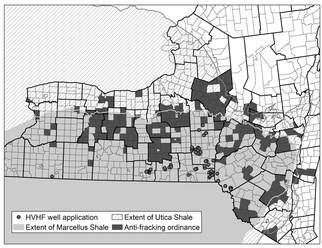
Whose Backyard and What's at Issue? Spatial and Ideological Dynamics of Opposition to Fracking in New York State, 2010 to 2013
American Sociological Review, 2016 81(5): 921-948.
What drives local decisions to prohibit industrial land uses? This study examines the passage of municipal ordinances prohibiting gas development using hydraulic fracturing (“fracking”) in New York State. I argue that local action against fracking depended on multiple conceptions of the shale gas industry. Matching these alternative conceptions with prevailing spatial models of public response to industrial land uses—“not in my backyard,” “not in anyone’s backyard,” and “please in my backyard”—improves our understanding of where local contention might emerge and how it contributes to policy change. Results from event history and logistic regression analyses show, first, that communities lying above favorable areas of the shale did not pass anti-fracking laws because opposition to fracking was counteracted by significant local support for development. Fracking bans passed primarily in a geographic sweet spot on the periphery of targeted regions, where little or no compelling economic interest in development existed. Second, as fracking became the subject of a highly politicized national debate, local opposition increasingly reflected mobilization by political liberals. This trend is reflected in the increasing rate of ordinance adoption among Democratic-leaning communities outside the geographic sweet spot.
American Sociological Review, 2016 81(5): 921-948.
What drives local decisions to prohibit industrial land uses? This study examines the passage of municipal ordinances prohibiting gas development using hydraulic fracturing (“fracking”) in New York State. I argue that local action against fracking depended on multiple conceptions of the shale gas industry. Matching these alternative conceptions with prevailing spatial models of public response to industrial land uses—“not in my backyard,” “not in anyone’s backyard,” and “please in my backyard”—improves our understanding of where local contention might emerge and how it contributes to policy change. Results from event history and logistic regression analyses show, first, that communities lying above favorable areas of the shale did not pass anti-fracking laws because opposition to fracking was counteracted by significant local support for development. Fracking bans passed primarily in a geographic sweet spot on the periphery of targeted regions, where little or no compelling economic interest in development existed. Second, as fracking became the subject of a highly politicized national debate, local opposition increasingly reflected mobilization by political liberals. This trend is reflected in the increasing rate of ordinance adoption among Democratic-leaning communities outside the geographic sweet spot.